Six Programs Receive Education Honor Awards
Curricula emphasize alignment with the future of the profession
Summary: Recognizing excellence in architecture education through classroom, studio, and community work, the AIA Education Honor Awards Program honors six programs for 2008. The power of design is demonstrated in these courses in terms of sustainability, community development, collaboration, and global reach, commented Jury Chair Joyce M. Noe, FAIA. “The six programs selected this year are in sync with and reflect many of the same priorities as the AIA,” she says.
The Education Honor Awards, created in 1988, recognize the achievement of outstanding individuals who serve the profession through their commitment to teaching excellence. Courses, initiatives, or programs completed within the previous five years that are part of a program accredited by the National Architectural Accrediting Board (NAAB) or the Canadian Architectural Certification Board (CACB) and that have not previously received an AIA Education Honor Award are eligible for consideration. The awards will be presented in May during the 2008 AIA National Convention and Design Exposition in Boston.
According to the criteria for selection, the jurors sought evidence of exceptional and innovative courses that deal with broad issues, particularly in cross-disciplinary collaboration and/or within the broader community; contribute to the advancement of architecture education; have the potential to benefit and/or change practice; and/or promote models of excellence that can be appropriated by other educators. The courses submitted ranged from first-year to graduate level endeavors.
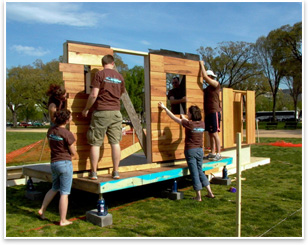 The Learning Barge Project: Students Engaging the Community + Environment The Learning Barge Project: Students Engaging the Community + Environment
Phoebe Crisman
School of Architecture, University of Virginia
In The Learning Barge Project, architecture, engineering, landscape, education, and history students are creating a floating self-powered field laboratory to teach visitors about solar and wind energy, rainwater collection systems, and related sustainable practices. Not only are architecture students learning about ecological systems, the barge, as it travels the Elizabeth River, will engage 19,000 people each year through interactive K-12 school trips, teacher training, and public workshops. The jury was especially impressed at this good example of promoting “ecological literacy” in architecture education. Support came from the Virginia Environmental Endowment, Lowe’s Educational & Charitable Foundation, U.S. Environmental Protection Agency, and the National Council of Architectural Registration Boards.
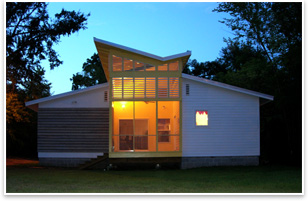 Design/habitat 2 Design/habitat 2
David Hinson, FAIA, and Stacy Norman, AIA
School of Architecture, Auburn University
This initiative combined factory-based prefabrication with traditional site-built construction to create a model for disaster relief in situations where there is a lack of community-based volunteer builders, such as the post-Katrina Gulf Coast. Students spent 10 months researching, designing a hybrid modular/site-built solution, and constructing their award-winning home. “The resultant model is superior design at low cost for Habitat for Humanity,” the jury said. They commended the program for bringing socially aware volunteer efforts into the realm of teaching and allowing students to investigate different modes of processing both design information and building sequencing.
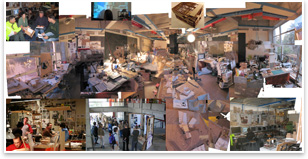 The Collaborative Integrative-Interdisciplinary Digital-Design Studio The Collaborative Integrative-Interdisciplinary Digital-Design Studio
Thomas Fowler
College of Architecture and Environmental Design, California Polytechnic State University, San Luis Obispo
The studio ties third- and fourth-year level design and building technology courses to connect students, faculty, and professionals in community design projects with real clients and budgets. Extensive use of digital media develops the requisite attitudes, awareness, and skills to thrive in today’s media-driven world. “Quite forward thinking,” commented the jury, noting that students refined interpersonal skills and produced a variety of built works. The one- to two-day conceptual charrettes and three- to four-week construction projects—some requiring grant-proposal research—emphasized the importance of multidisciplinary team collaboration while still reinforcing the importance of individual creativity.
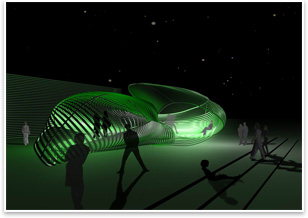 Smart Structures—Experiments in Linking Digital and Physical Design Strategies Smart Structures—Experiments in Linking Digital and Physical Design Strategies
Edgar Stach
College of Architecture and Design, the University of Tennessee, Knoxville
The Smart Structures lab brought together students and faculty from the U.S., the Netherlands, and Germany to focus on new ideas in digital design and synthetic fabrication. The work clearly shows the potential of global collaboration on a shared digital platform, melding design and manufacturing. By using a shared database, students interacted to create designs and fabricate components without regard to geographic location. “Quite inspirational,” the jury noted, “the work clearly shows that successful global collaboration is possible.”
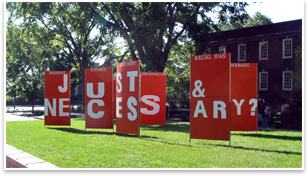 Design and Democracy Design and Democracy
Peter Aeschbacher
Department of Architecture, the Pennsylvania State University
As part of national Constitution Day, first-year students designed, built, and installed temporary projects that would “foster democratic engagement,” Aeschbacher writes. This is a great introduction for first year students to consider the relationship between societal and architectural realms, the jury said. By engaging with a topic outside traditional bounds of architecture, students were challenged to translate the topic and thus learn that good inquiry leads to good design. Focusing on public work developed an appreciation for the power and responsibility of design in shaping the world.
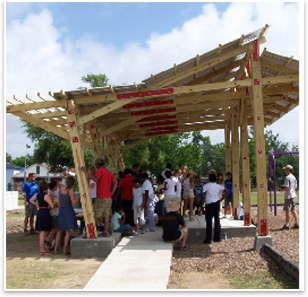 An Incomplete Curriculum for Transformation An Incomplete Curriculum for Transformation
Ritu Bhatt; Renee Cheng, AIA; John Comazzi; Ozayr Saloojee; Marc Swackhamer
School of Architecture, College of Design, University of Minnesota
Looking to prepare students for the future of the profession, this curriculum-development exercise explores the possibilities of an “evolving curricular structure” that builds on tradition, embraces challenges, and expects change. The jury cited the holistic goals of the program—collaboration with professionals, coordinated design studios, infusion of workshops, and focus on critical thinking—as worthy of recognition. Its “ambitious, out of the box outcomes are worth looking forward to,” the jury said.
|







 An Incomplete Curriculum for Transformation
An Incomplete Curriculum for Transformation